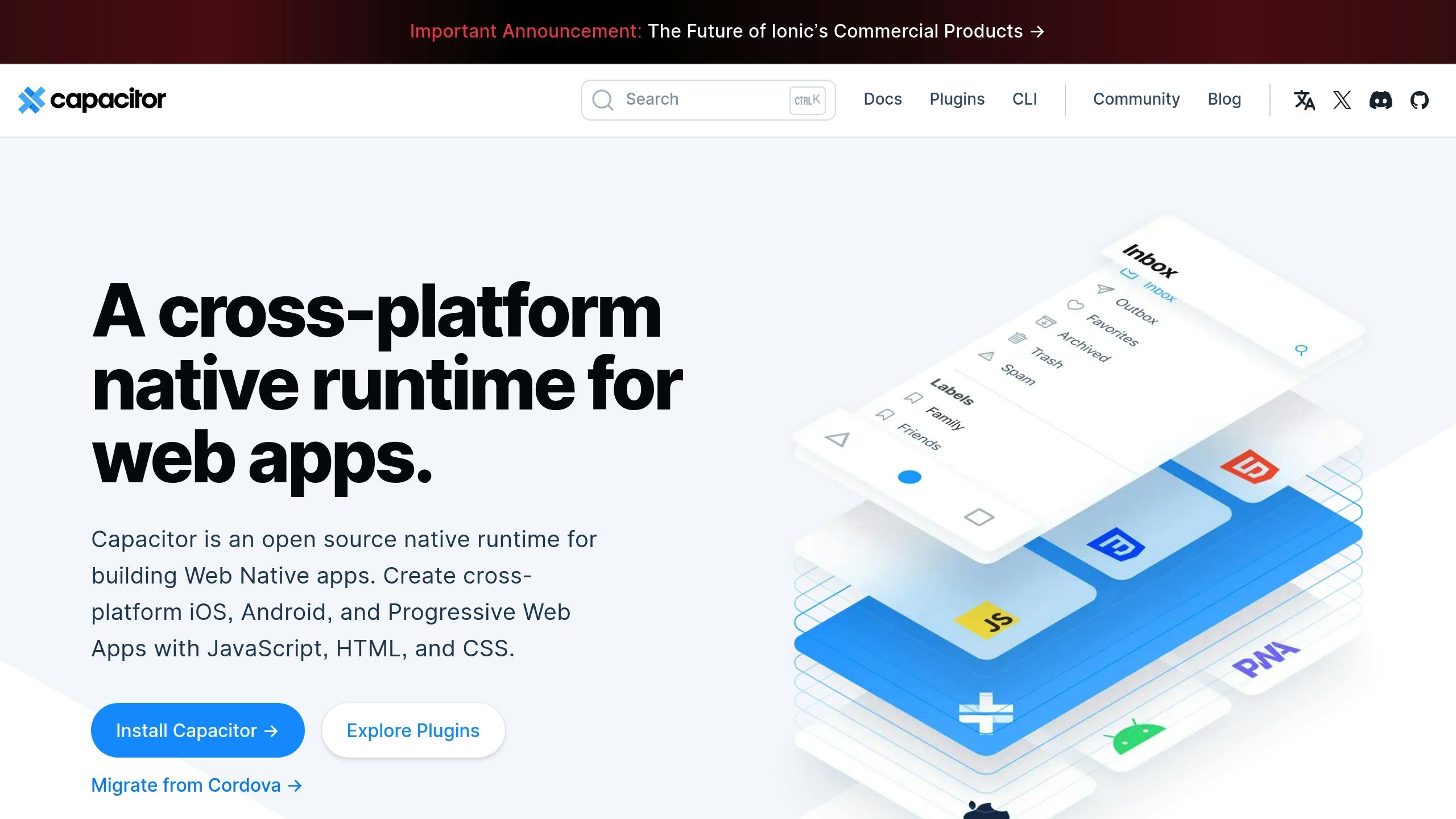- Native Bridge: Translates JavaScript into native actions (e.g., accessing the camera or GPS).
- Plugin System: Securely links web and native layers for smooth communication.
- Live Updates: Push updates directly to users without app store delays.
- Custom Plugins: Create plugins to access advanced device features like biometric authentication or specialized sensors.
- Performance: Fast loading (114ms for 5MB bundles) and global reliability (82% success rate).
Quick Overview
| Feature | Example Implementation | Benefit |
|---|---|---|
| Camera Access | Camera.getPhoto() | Capture photos easily |
| Geolocation | Geolocation.getCurrentPosition() | Track user location |
| File System | Filesystem.readFile() | Manage device storage |
| Live Updates | Delivered in 114ms | Faster updates to users |
Capacitor helps developers combine the flexibility of web development with the power of native apps. Keep reading to learn how it works and how tools like Capgo make it even better.
Building Web Native Apps with Capacitor 3

Core Bridge Functions
Capacitor’s native bridge acts as a crucial link, allowing web applications to interact directly with device capabilities through native code.
Native Bridge Basics
The bridge works by translating JavaScript requests into native platform code. For example, when a web app requests access to the camera, the bridge converts that request into Swift for iOS or Java/Kotlin for Android, executes the action, and sends the result back to the web application.
Bridge Benefits
The native bridge offers several advantages for cross-platform development:
| Benefit | Description | Impact |
|---|---|---|
| Load Time | 114ms average for 5MB bundles [1] | Faster app response times |
| Update Reach | 95% of users updated within 24h [1] | Rapid feature rollouts |
| Market Coverage | 82% global success rate [1] | Reliable performance worldwide |
| API Response Time | 434ms average globally [1] | Smooth and efficient interactions |
“We practice agile development and @Capgo is mission-critical in delivering continuously to our users!” – Rodrigo Mantica, @manticarodrigo [1]
Plugin Communication System
The plugin system simplifies and secures data exchange between the web and native layers using a standardized API. It has proven to be effective in real-world applications:
- Scale: Used in 750 apps currently in production [1]
- Reliability: Over 23.5 million updates delivered [1]
- Performance: 434ms average API response time globally [1]
This system also includes end-to-end encryption, ensuring secure data transfer. It gives developers the tools to create secure, high-performing apps that work seamlessly across platforms.
Web Code to Native Features
Using Native APIs in JavaScript
Capacitor makes it simple to access native device features using its JavaScript API. Here’s a quick look at how some common features are implemented:
| Native Feature | JavaScript Implementation |
|---|---|
| Camera Access | Camera.getPhoto() |
| Geolocation | Geolocation.getCurrentPosition() |
| File System | Filesystem.readFile() |
| Device Info | Device.getInfo() |
Capacitor takes care of platform-specific differences for you. It automatically triggers the right permission dialogs on both iOS and Android, all while providing a consistent JavaScript interface. Let’s dive into how its plugin system ensures secure and efficient communication between web code and native features.
Plugin Structure
Capacitor’s plugin system is designed to make communication between web and native code efficient and secure. It works through three key layers:
- Request Layer: Ensures incoming calls are properly validated and sanitized.
- Translation Layer: Converts JavaScript calls into platform-specific actions.
- Response Handler: Handles data flow, processes errors, and manages type conversions.
This structure ensures smooth and reliable interaction between your web app and native device features.
Native Code to Web Features
Web Events from Native Code
Capacitor’s bridge allows real-time updates to the web layer with minimal effort. Developers can manage native events effectively using specific methods designed for each event type:
| Event Type | Implementation Method | Use Case |
|---|---|---|
| Push Notifications | notifyListeners() | Informing the web layer about new messages |
| Location Updates | Events.emit() | Sending GPS coordinate changes |
| Hardware Status | Bridge.triggerWindowEvent() | Reporting changes like battery or network status |
Capgo ensures consistent event handling across different versions. Next, let’s dive into how native code delivers real-time data to web components.
Native Data Updates
After triggering events, updating data from native code to the web is just as seamless. With Capgo’s live update capabilities, this method becomes a reliable choice for dynamic applications.
// Native code triggering web updatesCapacitor.Bridge.triggerWindowEvent('dataUpdate', { type: 'sensor', value: newReading});Capgo’s CDN ensures quick delivery, handling a 5 MB bundle in just 114 ms, keeping updates smooth and efficient.
To make native data updates even better, consider these tips:
- Batch Updates: Combine related data changes to reduce the number of bridge calls.
- Event Debouncing: Limit high-frequency native events to avoid overwhelming the system.
- Error Handling: Use strong error management strategies on both the native and web sides.
Capacitor’s bridge, paired with Capgo’s update system, creates a dependable setup for native-to-web communication.
Creating Custom Plugins
Using Capacitor’s native bridge, custom plugins enable communication between web and native layers, unlocking access to advanced device features.
Plugin Development Steps
1. Set Up Your Development Environment
Create a plugin directory with the following structure:
my-plugin/ ├── android/ ├── ios/ ├── src/ └── package.json2. Define the Plugin Interface
Write a TypeScript interface to specify how your plugin will work:
export interface MyPluginInterface { nativeFeature(options: { param1: string, param2: number }): Promise<{ result: string }>;}3. Implement Native Code
Add platform-specific functionality for iOS and Android. For example, in Swift:
@objc func nativeFeature(_ call: CAPPluginCall) { let param1 = call.getString("param1") ?? "" let param2 = call.getInt("param2") ?? 0
// Add native functionality here call.resolve([ "result": "Success" ])}Once your framework is in place, you can build plugins tailored to your app’s specific needs.
Custom Plugin Applications
Custom plugins fill gaps left by standard web APIs. Below is a table showcasing real-world examples:
| Use Case | Plugin Category | Example |
|---|---|---|
| Biometric Auth | Security | Fingerprint or face recognition |
| Custom Hardware | Device | Integrating specialized sensors |
| File Handling | Storage | Custom encryption for files |
When creating custom plugins, keep these tips in mind:
- Error Handling: Ensure your plugin handles errors effectively on both web and native sides.
- Documentation: Provide clear API documentation and maintain version history.
- Version Management: Follow semantic versioning to manage updates reliably.
Capgo’s update system simplifies plugin deployment, making it easy to distribute updates across your app’s user base while ensuring compatibility and version control.
Testing and Performance
Debug Tools
Capacitor includes built-in tools to help troubleshoot issues with bridge communication. Two essential tools for monitoring web-to-native calls are Chrome DevTools and Safari Web Inspector. You can also enable detailed logging in your Capacitor configuration like this:
const cap = Capacitor.init({ debugMode: true, logLevel: 'debug'});For debugging on the native side:
- iOS: Use Xcode’s Console and Breakpoints.
- Android: Use Android Studio’s Logcat with the
Capacitor/Consolefilter.
Let’s dive into common bridge issues and how to resolve them.
Common Problems and Solutions
Bridge communication issues often fall into these categories:
| Issue | Cause | Solution |
|---|---|---|
| Timeout Errors | Slow native operations | Add timeout handling and use progress callbacks |
| Data Type Mismatches | Incorrect parameter types | Validate data types using TypeScript interfaces on both ends |
| Memory Leaks | Unremoved event listeners | Clear listeners in ionViewWillLeave or during component cleanup |
To reduce failures, follow these practices:
- Use try-catch blocks around bridge calls to handle errors gracefully.
- Validate request data to ensure it matches the expected structure before sending.
- Check connection status before making calls to monitor the bridge state.
Speed Improvements
Once you’ve identified issues, you can improve bridge performance by optimizing data transfer, event handling, and cache management.
Data Transfer:
- Send only the necessary data to minimize payload size.
- Use binary formats for large data transfers to improve efficiency.
- Combine multiple requests into a single batch whenever possible.
Event Handling: Instead of triggering multiple updates, group them into one callback for better performance:
bridge.on('dataChange', () => { // Combine updates into a single callback this.batchUpdate();});Cache Management:
- Store frequently accessed native data in web storage for quicker retrieval.
- Use an LRU (Least Recently Used) cache for API responses.
- Regularly clear caches to prevent them from becoming too large.
For real-time features, consider using a message queue to avoid bottlenecks. When deploying live updates, Capgo’s performance monitoring tools can help reduce bridge overhead and ensure smoother feature rollouts.
Live Updates with Capgo

Capgo Features
Capgo makes it easier to update Capacitor apps by allowing instant code deployments, skipping the need for app store reviews. It provides updates with end-to-end encryption and uses an advanced channel system for targeted delivery.
Performance data shows Capgo’s reliability in real-world use, supporting 750 apps in production environments [1]. It works with both cloud and self-hosted setups and integrates seamlessly into CI/CD workflows for automated processes.
Let’s dive into how Capgo’s update system brings these features to life.
Capgo Update System
The update system operates in three steps:
-
Installation and Setup
Start by initializing Capgo with the following command:
Terminal window npx @capgo/cli init -
Update Distribution
Capgo’s channel system makes distributing updates efficient by offering:
- Partial updates to save bandwidth
- Background installations that don’t interrupt users
- Automatic version management with rollback options
-
Security and Compliance
Capgo ensures updates meet Apple and Google guidelines by using end-to-end encryption. It also includes built-in error tracking and analytics for added reliability.
This system works seamlessly with Capacitor’s native bridge, making app updates smooth and hassle-free. These features set Capgo apart in the live update market.
Update Service Options
Capgo stands out among live update services for Capacitor apps thanks to several key factors:
| Feature | Capgo | Market Context |
|---|---|---|
| Pricing Model | Starting at $12/month | Affordable for both small and large teams |
| Update Delivery | 114ms average | Faster than most competitors |
| User Limit | 1,000 to 1M+ MAU | Scales with growing apps |
| Storage | 2GB to 20GB | Flexible storage options |
| Bandwidth | 50GB to 10TB | Built for enterprise needs |
“We practice agile development and @Capgo is mission-critical in delivering continuously to our users!” - Rodrigo Mantica [1]
For teams switching from other platforms, Capgo offers smooth migration options and full support. With its strong presence in the Capacitor ecosystem, Capgo is a dependable choice for continuous deployment.
Summary
Capacitor’s bridge system streamlines hybrid app development by facilitating smooth communication between web and native layers. This makes accessing native features simpler, while also improving deployment processes and enhancing the overall user experience.
Live update platforms like Capgo build on this efficiency. With 23.5 million updates delivered across 750 production apps, Capgo ensures 95% of active users receive updates within 24 hours, achieving an 82% global success rate [1]. The platform consistently delivers updates securely, with impressive speed and reliability [1].




